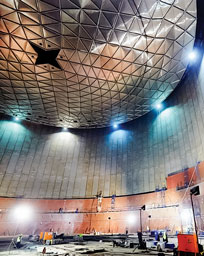Boxscore Construction Analysis
A. Blume, Editor
Gaz-System sa’s $3-B, 5-Bcmy Świnoujście LNG terminal (also referred as Polskie LNG) is an LNG import terminal under construction in Świnoujście, Poland. The project was first conceived in 2006 by Polskie Górnictwo Naftowe i Gazownictwo (PGNiG), from which Gaz-System was created and divulged as a separate entity to take over the Polskie LNG project.
The terminal will reduce Poland’s dependence on Russian gas supplies and create a new market in the Baltic region. At present, Europe operates only 21 of the world’s approximately 94 LNG regasification terminals.
Project design and progress. SNC-Lavalin was awarded the $10.5-MM FEED contract in early 2008, while the $930-MM EPC contract is being delivered by a consortium of Saipem, Techint, Snamprogetti and PBG. Construction of the terminal began in March 2011. The project was delayed from its original completion date of June 2013 due to cost overruns; however, it is expected to be completed by 2Q 2016 after Poland’s PGNiG infused an additional $762 MM of investment in the project.
Out of a CAPEX of $3 B, $266 MM will be provided by the European Bank for Reconstruction and Development. The remaining $1 B will be arranged by purchase of $100 MM of Polskie LNG bonds by each of 10 other banks.
The LNG terminal will be built on the right bank of the Swina River, on land that was long designated for port development. An LNG receiving terminal with vaporizing facilities and LNG carrier unloading facilities (Fig. 1) for large LNG tankers will be built. Pipelines for the offtake of liquefied gas from ships will also be constructed as part of the project, as well as LNG tanks and regasification facilities. The gas in gaseous form will then be transported via a network of gas pipelines to the customers. The construction of two standard-sized storage containers (Fig. 2) with a capacity of 160 Mcm is planned.
 |
|
Fig. 1. Construction progress on the |
 |
|
Fig. 2. Construction progress on |
In October 2014, the project developers announced that they are considering expanding the project by adding a third storage tank (Fig. 3). If constructed, the terminal’s capacity would increase from 5 Bcmy to 7.5 Bcmy. There is also a plan to create a gas corridor from the Polskie LNG terminal to the Adria LNG terminal in Croatia.
 |
|
Fig. 3. Inside view of one of the |
Gas import reduction. Poland hopes the terminal will become a future natural gas trading hub for central and northern Europe, and help diversify its sources of energy away from Russia.
At present, Poland imports as much as 10 Bcmy of gas from Russia. The new terminal is anticipated to cut that import volume in half, to 5 Bcmy. The Polish government is also investigating the possibility of a gas pipeline from Norway, Ukraine, Denmark or Germany.
Future considerations. A number of updates to the Polskie LNG terminal may be considered in the future:
- Increased regasification capacity
- LNG truck cistern loading
- LNG rail cistern loading for further distribution
- Reloading to smaller vessels for further distribution
- LNG storage in the terminal in tanks, without regasification immediately after delivery.
Regardless of whether Polskie LNG chooses to carry out these proposed modifications, the impending finalization and startup of the terminal will make an essential contribution to Europe’s regasification capacity. It will also mark an important step toward Poland’s achievement of greater gas supply diversification. GP




Comments